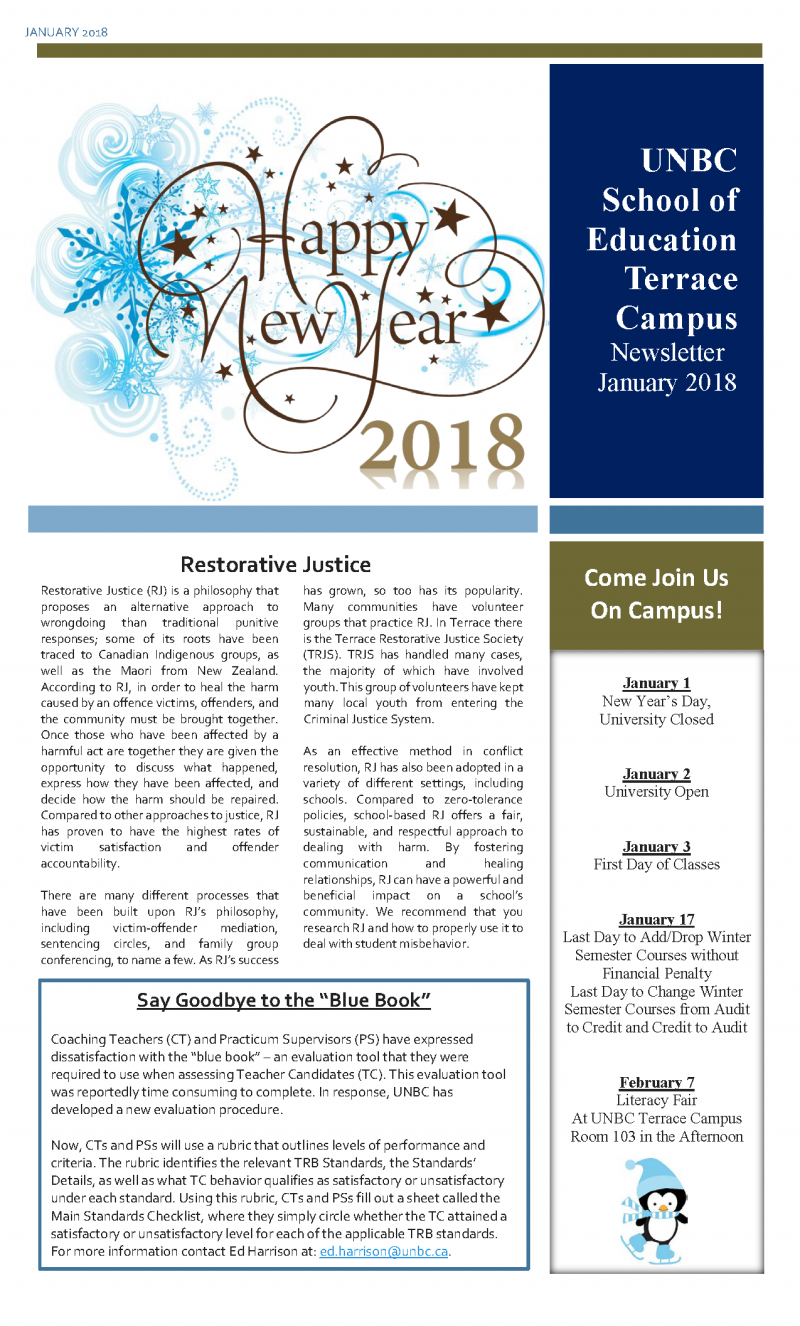School of Education Newsletter - January 2018
Campus
Newsletter
January 16, 2018

School of Education January 2018 Newsletter
Restorative Justice
Restorative Justice (RJ) is a philosophy that proposes an alternative approach to wrongdoing than traditional punitive responses; some of its roots have been traced to Canadian Indigenous groups, as well as the Maori from New Zealand. According to RJ, in order to heal the harm caused by an offence victims, offenders, and the community must be brought together. Once those who have been affected by a harmful act are together they are given the opportunity to discuss what happened, express how they have been affected, and decide how the harm should be repaired. Compared to other approaches to justice, RJ has proven to have the highest rates of victim satisfaction and offender accountability.
There are many different processes that have been built upon RJ’s philosophy, including victim-offender mediation, sentencing circles, and family group conferencing, to name a few. As RJ’s success has grown, so too has its popularity. Many communities have volunteer groups that practice RJ. In Terrace there is the Terrace Restorative Justice Society (TRJS). TRJS has handled many cases, the majority of which have involved youth. This group of volunteers have kept many local youth from entering the Criminal Justice System.
As an effective method in conflict resolution, RJ has also been adopted in a variety of different settings, including schools. Compared to zero-tolerance policies, school-based RJ offers a fair, sustainable, and respectful approach to dealing with harm. By fostering communication and healing relationships, RJ can have a powerful and beneficial impact on a school’s community. We recommend that you research RJ and how to properly use it to deal with student misbehaviours.
Say Goodbye to the "Blue Book"
Coaching Teachers (CT) and Practicum Supervisors (PS) have expressed dissatisfaction with the “blue book” – an evaluation tool that they were required to use when assessing Teacher Candidates (TC). This evaluation tool was reportedly time consuming to complete. In response, UNBC has developed a new evaluation procedure.
Now, CTs and PSs will use a rubric that outlines levels of performance and criteria. The rubric identifies the relevant TRB Standards, the Standards’ Details, as well as what TC behavior qualifies as satisfactory or unsatisfactory under each standard. Using this rubric, CTs and PSs fill out a sheet called the Main Standards Checklist, where they simply circle whether the TC attained a satisfactory or unsatisfactory level for each of the applicable TRB standards. For more information contact Ed Harrison at: ed.harrison@unbc.ca.
Now, CTs and PSs will use a rubric that outlines levels of performance and criteria. The rubric identifies the relevant TRB Standards, the Standards’ Details, as well as what TC behavior qualifies as satisfactory or unsatisfactory under each standard. Using this rubric, CTs and PSs fill out a sheet called the Main Standards Checklist, where they simply circle whether the TC attained a satisfactory or unsatisfactory level for each of the applicable TRB standards. For more information contact Ed Harrison at: ed.harrison@unbc.ca.
A Letter from China #3: Update from Alyssa Carson (2017 UNBC B.Ed. Graduate)
Ni hao!
It has been a while since my last letter and I do not even know where to begin with this one! Between regular teaching duties (7:30am – 3:30pm), hosting and coaching our team in the Maple Leaf Ultimate Frisbee Tournament, being a judge for the Maple Leaf Speech Cup, running the Ball Hockey Club, helping with intramurals, participating in multiple mental health awareness events, the New Year`s gala, and learning Mandarin, I have not had much spare time to catch up with everyone back home and have been an exceptionally bad communicator. Sorry! On a side note, I have finally adjusted to the early mornings and feel as though I have levelled up as an adult!
We are currently wrapping up the first semester here at Maple Leaf, with a full week dedicated to final exams, marking, reporting, and prepping for the next semester (which includes a day trip to the driving range to hit a bucket of balls with the principal and one of our secretaries – I love teaching PE)! The only downside to exam week is that PE teachers have to conform to the regular dress code, but I suppose I can trade my track pants in for five days of uninterrupted prep time! Next week, I should begin teaching PE 12: Golf Academy, Active Living (ESL Foundations course), and another block of Planning 10 (more Sex Ed!), provided there are no scheduling surprises. The educational system is a little different here, so between grade 12 students wanting to retake courses to boost their GPAs and grade 10 students writing BC entrance exams, there is always a little bit of course juggling at this time.
Apart from teaching, I have been fortunate enough to use my new home in Yongchuan as a launching point for travelling! Since moving here in August, I have been to Chongqing, Beijing, Chengdu, and Shanghai (Disneyland) in China, and I have made a quick weekend trip to Malaysia to cheer on a teacher friend who happens to run marathons around the globe. I also just booked plane tickets to Thailand for the Chinese New Year holiday; I will be spending most of February in the ocean, getting my Open Water and Advanced Divers scuba certifications!
Living in China is proving to be an incredible experience and I feel as though I am growing beyond measure both professionally and personally. It isn't always easy living here, but there is nowhere else I would rather be!
Alyssa
PS. Best of luck to the new teacher candidates in your upcoming practicum placement!
Linda's Links
- Canadian Geographic’s Giant Floor Map program is a free resource offered to teachers K-12. The maps are roughly ½ the size of a school gym. There are 7 giant maps available with curriculum-linked activities.
- Bring Canada's capital into your classroom with these free, bilingual teaching resources.
Media
